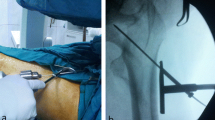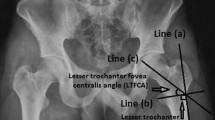Abstract
The study is a prospective evaluation and comparison. A minimally invasive Dynamic Hip Screw (MIDHS) technique is presented. One hundred and two patients with intertrochanteric fractures were treated with either a MIDHS or a conventional dynamic hip screw (CDHS). We used the Singh index as a measure of osteoporosis and also classified the fractures according to three different systems (OTA, Boyd-Griffin, and Evans). All patients were followed up for 12 months with a hip score evaluation. The patients were divided into two groups, based on the method of treatment. The MIDHS group includes 42 patients with an average age of 72.6 years. The CDHS group includes 60 patients, with an average age of 71.3 years. Both groups were similar in injury mechanism, fracture types, mean Singh index and confounding medical condition (all p values >0.05). The CDHS group had significantly larger wound incision, greater haemoglobin level drop, higher pain level, more total analgaesic use and longer hospital stay than the MIDHS group (all p values<0.05). The hip score, union rate, healing time, adequate reduction and adequate screw position rate was not significantly different between the two groups (all p values >0.05). In conclusion, either a MIDHS or a CDHS in the treatment of intertrochanteric fractures is an effective, simple and safe method. The mini-invasive technique as opposed to the conventional technique has smaller wound size, lower pain level, and lower blood loss. Hospital stay and total analgaesic use were decreased, benefitting the patient and reducing hospital cost.
Résumé
Etude prospective de 102 patients avec une fracture intertrochantérienne traitée par une vis-plaque dynamique soit avec une technique mini-invasive (MIDHS) soit avec une technique conventionnelle (CDHS). L’index de Singh était utilisé pour la mesure de l’ostéoporose et les fractures étaient classées selon trois systèmes : OTA, Boyd-Griffin et Evans. Tous les patients étaient suivi 1 an. Le groupe MIDHS comprenait 42 patients d’âge moyen 72,6 ans et le groupe CDHS comprenait 60 patients d’âge moyen 71,3 ans. Les 2 groupes étaient similaires pour le mécanisme du traumatisme, le type de la fracture, l’index de Singh et les conditions médicales générales (toujours p<0,05). Le groupe CDHS avait une plus longue incision cutané, une plus grande chute du taux d’hémoglobine, un plus haut niveau de douleurs, et un séjour hospitalier plus long que l’autre groupe (p<0,05). En conclusion les 2 méthodes de traitement étaient efficaces et sûres. La technique mini-invasive permettait une incision plus courte, un niveau de douleurs et une perte sanguine plus faibles. La durée de séjour et la consommation d’analgésiques etaient diminuées au profit du patient et du coût hospitalier.




Similar content being viewed by others
References
Alobaid A, Harry EJ, Elder GM et al (2004) Prospective randomized trial of two techniques of insertion of a standard dynamic fixation device. J Orthop Trauma 18(4):207–212
Audige L, Hanson B, Swiontkowski MF (2003) Implant-related complications in the treatment of unstable intertrochanteric fractures: meta-analysis of dynamic screw-plate versus dynamic screw-intramedullary nail devices. Int Orthop 27(4):197–203
Aune AK, Ekeland A, Odengaard B et al (1994) Gamma nail vs compression screw for trochanteric femoral fractures. Acta Orthop Scand 65:127–131
Barquet A, Francescoli L, Rienzi D et al (2000) Intertrochanteric-subtrochanteric fractures: treatment of the long Gamma nail. J Orthop Trauma 14:324–328
Bolhofner B, Russo P, Carmen B (1999) Results of intertrochanteric femur fractures treated with a 135-degree sliding screw with a two-hole side plate. J Orthop Trauma 13:5–8
Boyd HB, Griffin LL (1949) Classification and treatment of trochanteric fractures. Arch Surg 58:853–866
Cobelli NJ, Sadler AH (1985) Ender rod versus compression screw fixation of hip fractures. Clin Orthop 201:123–127
DeLee JC (1991) Fractures and dislocations of the hip. In: Rockwood CA Jr, Green DP, Bucholz RW (eds) Rockwood and Green’s fractures in adult, ed 3. PA, Philadelphia pp 1481–1651
Domingo LJ, Cecilia D, Herrera A et al (2001) Trochanteric fractures treated with a proximal femoral nail. Int Orthop 25(5):298–301
Egol KA, Koval KJ (2002) Hip: Trauma. In Orthopaedic knowledge update 7:407–416
Evans EM (1949) The treatment of trochanteric fractures of the femur. J Bone Joint Surg Br 31:191–203
Kaufer H, Matthews LS, Sonstegard D (1974) Stable fixation of intertrochanteric fractures. J Bone Joint Surg Am 56: 899–907
Kyle RF, Gustilo RB, Premer RF (1979) Analysis of six hundred and twenty-two intertrochanteric hip fractures. J Bone Joint Surg Am 61:216–221
LaVelle DG (2003) Fractures of hip. In: Canale ST Cambpbell’s operative orthopaedics. PA, Philadelphia pp 2873–2938
McLoughlin S, Wheeler D, Rider J et al (2000) Biomechanical evaluation of the dynamic hip screw with two- and four-hole side plates. J Orthop Trauma 14:318–323
Orthopaedic Trauma Association (1996) Fracture and dislocation compendium. J Orthop Trauma 10(1):31–35
Singh M, Nagrath AR, Maini PS (1970) Changes in trabecular pattern of the upper end of the femur as an index of osteoporosis. J Bone Joint Surg Am 52:457–467
Vossinakis IC, Badras LS (2001) Management of pertrochanteric fractures in high-risk patients with an external fixation. Int Orthop 25(4):219–222
Wiss D (2001) What’s new in orthopaedic trauma? J Bone Joint Surg Am 83:1762–1772
Yian EH, Bancrji I, Matthcws LS (1997) Optimal side plate fixation for unstable intertrochanteric hip fractures. J Orthop Trauma 11(4):254–259
Author information
Authors and Affiliations
Corresponding author
Rights and permissions
About this article
Cite this article
Lee, YS., Huang, HL., Lo, TY. et al. Dynamic hip screw in the treatment of intertrochanteric fractures: a comparison of two fixation methods. International Orthopaedics (SICO 31, 683–688 (2007). https://doi.org/10.1007/s00264-006-0248-y
Received:
Accepted:
Published:
Issue Date:
DOI: https://doi.org/10.1007/s00264-006-0248-y




